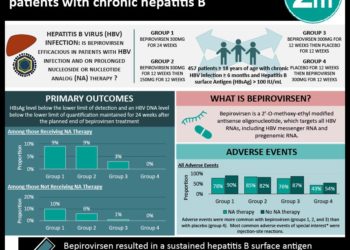Direct-acting antiviral therapy for hepatitis C virus associated with hepatitis B virus reactivation in co-infected patients
1. Patients who have been infected with hepatitis B virus (HBV) and are being treated with direct-acting antiviral agents (DAAs) for hepatitis C virus (HCV) infection should be monitored during their treatment course for possible development of HBV reactivation (HBV-R).
2. HBV-R is a manageable adverse event, and DAAs continue to be a safe and very effective treatment for infection with HCV.
Evidence Rating Level: 4 (Below Average)
Study Rundown: In the United States, chronic HCV infection is the top cause of cirrhosis, liver cancer, and liver transplant. DAA treatment for HCV gives patients a high chance of reaching a sustained virologic response (SVR), which is indicative of successful HCV infection treatment. SVR is the absence of HCV RNA detection in the blood for 12 weeks or more after completion of treatment. Co-infection with HBV is common in areas where HCV and HBV infections are endemic. HBV-R is a sudden increase in HBV replication in patients who have resolved or inactive HBV infection. To assess the safety concern that HBV-R could occur in patients taking HCV DAAs, the authors analyzed 29 different reports of HBV-R in such patients. In patients who developed HBV-R, there was heterogeneity in HCV subtype, DAAs administered, and HBV baseline characteristics. Patients who have been infected with HBV and are being treated with DAAs for HCV should be monitored during their treatment course for possible development of HBV-R. Further studies would help to determine which patients may be good candidates for HBV prophylaxis and treatment. The authors stated that HBV-R is a manageable adverse event if there is proper screening, monitoring, and treatment. The authors concluded that DAAs continue to be a safe and very effective treatment for infection with HCV.
A strength of this study is that this is the largest DAA-associated HBV-R case series that has been published thus far. Limitations of this study include possible underreporting of events, heterogeneity in data quality, and the lack of ability to quantify risk.
Click to read the study, published today in Annals of Internal Medicine
Relevant Reading: Direct-acting antiviral treatment in adults infected with hepatitis C virus: Reactivation of hepatitis B virus coinfection as a further challenge
In-Depth [case series]: In this study, the authors used the United States Food and Drug Administration Adverse Event Reporting System (FAERS) to find 28 cases meeting study criteria. Another case was included that was not found in FAERS but was reported in the literature. Of 29 reports, 19 and 5 patients were from Japan and the United States, respectively. The patients had a mean age of 60.7 years, and 55% were female. HBV-R usually happened 4 to 8 weeks after DAA therapy commenced. Three patients developed decompensated liver failure, followed by 2 deaths and 1 liver transplantation. Another patient had fulminant liver failure. Of 8 patients identified as clinically ill due to HBV-R, 5 treated patients had declines in hepatitis symptoms, HBV DNA levels, and transaminase levels. HBV antiviral therapy (either tenofovir or entecavir) was received in 15 patients, 8 patients did not receive HBV infection treatment, and no treatment information was found for 6 patients. The mechanism for how DAA treatment could cause HBV-R is unknown.
Image: PD
©2017 2 Minute Medicine, Inc. All rights reserved. No works may be reproduced without expressed written consent from 2 Minute Medicine, Inc. Inquire about licensing here. No article should be construed as medical advice and is not intended as such by the authors or by 2 Minute Medicine, Inc.






